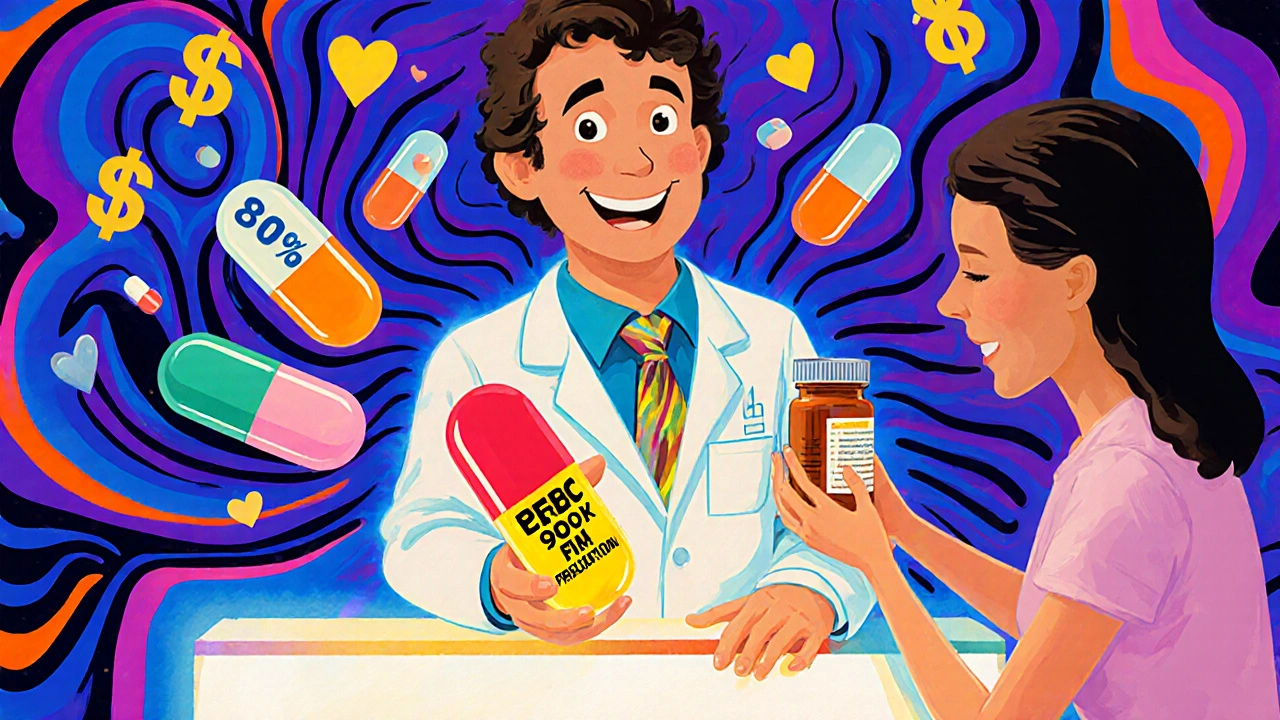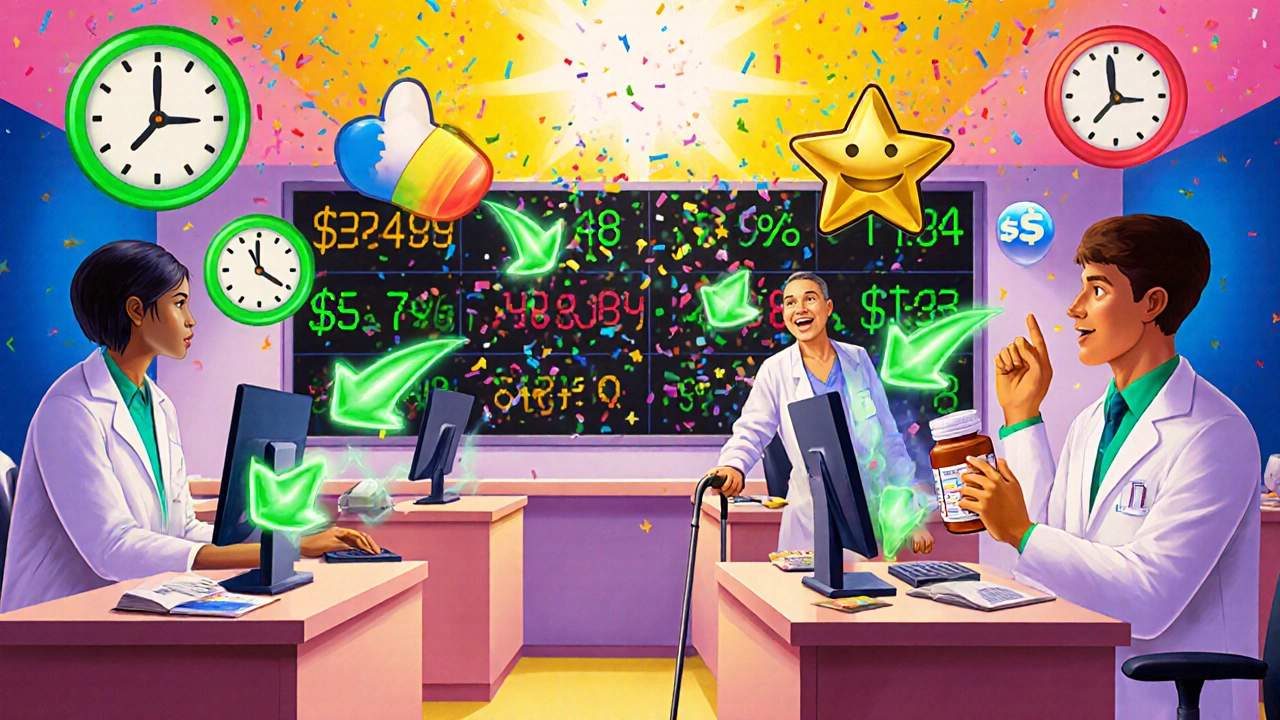Generic Prescribing Incentives: How Rewards Shape Provider Decisions

Why Doctors Get Paid to Prescribe Generic Drugs
It sounds simple: a doctor writes a prescription, the patient fills it, and everyone moves on. But behind that quiet exchange is a system of rewards, rules, and financial nudges designed to push doctors toward cheaper, equally effective generic medications. These aren’t just policies - they’re incentives. And they’re changing how care is delivered.
Generic drugs make up 90% of all prescriptions filled in the U.S. today. Yet they account for only about 23% of total drug spending. That’s because brand-name drugs can cost 10, 20, even 100 times more. For Medicare, Medicaid, and private insurers, that gap is a massive financial leak. So they started paying doctors - not to prescribe more drugs, but to prescribe the right ones. The goal? Save billions without hurting patients.
How These Incentives Actually Work
There’s no single way to reward doctors for prescribing generics. Programs vary wildly depending on who’s running them - a health plan, a hospital system, or a government agency. But the most common models fall into two buckets: money and convenience.
Financial rewards come in different shapes. Some insurers pay doctors $5 to $15 per generic prescription in targeted drug classes, like blood pressure or cholesterol meds. Others offer annual bonuses up to $5,000 if a provider hits a generic prescribing target. UnitedHealthcare’s Value-Based Prescribing Program, for example, increased generic use by nearly 25% in primary care clinics by tying bonuses to performance data pulled directly from electronic health records.
Non-financial perks matter too. Doctors who consistently choose generics often get faster prior authorizations, priority scheduling for patient referrals, or even public recognition in internal newsletters. Some systems automatically route generic prescriptions through simplified approval workflows, cutting down paperwork. For a busy clinic, that’s not just a convenience - it’s time saved.
The Power of Default Settings
One of the most effective - and quietest - tools in the incentive toolbox is the generic-first default in e-prescribing software. When a doctor opens the prescription screen, the system doesn’t show the brand-name drug first. It shows the generic. And studies show that’s enough to change behavior.
A 2020 Duke University study found that when e-prescribing systems defaulted to generics, doctors prescribed them 22.4 percentage points more often than when the brand was listed first. That’s not because doctors were forced. It’s because humans tend to go with the default unless they have a reason to change it. It’s called choice architecture. And it works.
But it’s not magic. These defaults only trigger when the generic is clinically equivalent. Good systems include alerts that pop up if a patient has had a bad reaction to a specific generic, or if the brand is medically necessary. The trick is making the system helpful, not annoying. Too many alerts, and doctors start ignoring them all.
When Incentives Backfire
Not all programs work as intended. Some create unintended consequences - and even perverse incentives.
Take the 340B Drug Pricing Program. It gives safety-net hospitals deep discounts on brand-name drugs. But a 2023 JAMA Health Forum study found that doctors at these hospitals prescribed generics 6.8% less often than others. Why? Because they’re getting the brand-name drugs cheaply. Saving money isn’t the goal anymore - using the discounted drug is.
Another problem shows up when doctors have direct financial ties to drug companies. Research from Duke found that physicians who receive payments, meals, or travel perks from pharmaceutical firms are 37% less likely to prescribe generics - especially in the first year after a generic hits the market. It’s not always about greed. Sometimes it’s about relationships. A rep who visits regularly, brings free samples, or sponsors a lunch can quietly shape prescribing habits.
Even the NHS in England found that when doctors could dispense drugs directly from their clinics, they prescribed 3.1% more expensive medications per patient. When the doctor profits from the sale, the incentive shifts - from patient care to profit.

What Providers Really Think
Doctors aren’t monolithic. Their opinions on these programs vary by experience, specialty, and practice setting.
On physician forums like Sermo, Dr. Michael Chen, an internal medicine doctor in California, said his UnitedHealthcare incentive added $2,800 to his annual income with almost no extra work. "It’s a win-win," he wrote. "I’m helping patients save money, and I get paid for it. No guilt involved."
But others feel trapped. Dr. Sarah Williams, a family physician in Texas, told Medscape: "Some programs feel coercive. What if my patient needs a specific brand because they’re allergic to the filler in the generic? Am I supposed to ignore that just to hit a target?"
Reddit threads from r/physicians echo this. One user, "MedDoc2020," wrote: "Generic incentives work great for hypertension or diabetes. But when you’re managing a patient with five chronic conditions, three allergies, and a history of non-adherence, you need flexibility. One-size-fits-all doesn’t cut it."
A 2021 MGMA survey of 1,200 providers found that 63% supported financial incentives - but only if they were voluntary and tied to quality, not just cost. Meanwhile, 78% worried that if patients found out their doctor was being paid to prescribe generics, trust would erode. "Patients don’t care about your bonus," one respondent said. "They care if you’re choosing what’s best for them."
How Europe Does It Better
The U.S. isn’t the only country trying to control drug costs. Germany’s system - called reference pricing - is often held up as a model.
In Germany, insurers don’t reimburse based on the brand-name price. They set a fixed reimbursement amount for each drug class - the price of the cheapest available generic. If a doctor prescribes a more expensive brand, the patient pays the difference out of pocket. No bonus for the doctor. No hidden incentives. Just transparency.
The result? 93% of off-patent drugs prescribed in Germany are generics. In the U.S., it’s about 85%. The difference? In Germany, the financial pressure is on the patient, not the provider. That removes the conflict of interest entirely.
Some U.S. insurers are testing similar ideas. CMS’s 2021-2022 ‘$2 Drug List’ trial set a flat $2 copay for 12 essential generics. Result? Generic use jumped 17.3% among Medicare patients. Patients started filling prescriptions more often. Adherence improved. Costs dropped. And doctors didn’t have to navigate bonus structures.
What’s Next for Provider Incentives
The future of these programs isn’t about bigger bonuses. It’s about smarter design.
UnitedHealthcare is rolling out its 2024 ‘value-based prescribing contracts’ - which tie payments not just to cost savings, but to clinical outcomes. Did the patient’s blood pressure drop? Did their cholesterol improve? Was adherence maintained? Now the bonus depends on health results, not just prescription counts.
The 2022 Inflation Reduction Act includes new rules to speed up generic approvals and break patent abuses. Experts predict that could push generic use to 94% by 2028.
But the biggest challenge isn’t technology or policy. It’s trust. If providers feel micromanaged, or if patients think their care is being rationed for profit, the whole system risks losing credibility.
What Makes a Good Incentive Program
Based on real-world results and provider feedback, the most successful programs share these traits:
- They’re transparent - providers know exactly how the bonus works.
- They’re flexible - exceptions are built in for complex cases.
- They’re tied to quality - not just cost savings.
- They use tech to help, not to punish - defaults, alerts, and workflows support decisions, not override them.
- They avoid direct financial ties to drug companies.
The American College of Physicians says it best: Prescribe generics when appropriate. Not because you’re being paid to. But because it’s the right thing to do - and the system should make that easy.
Can These Incentives Save Billions?
Yes - but only if they’re done right.
The Congressional Budget Office estimates generic prescribing incentives have already saved the U.S. healthcare system $1.7 trillion since 2009. With better design, they could save another $150-200 billion over the next decade.
But money isn’t the only metric. The real win is when patients get the meds they need, on time, at a price they can afford - and when doctors feel empowered, not pressured, to make the best choice.
Do generic drugs work as well as brand-name drugs?
Yes. By law, generic drugs must contain the same active ingredients, strength, dosage form, and route of administration as their brand-name counterparts. They’re tested to prove they work the same way in the body. The only differences are in inactive ingredients like fillers or dyes - which rarely affect how the drug works. For 90% of prescriptions, generics are just as safe and effective.
Why don’t all doctors prescribe generics all the time?
Some patients need specific formulations. For example, certain epilepsy or thyroid medications have narrow therapeutic windows - tiny differences in absorption can cause problems. Others have allergies to inactive ingredients in generics. Some patients also report feeling better on a brand, even if studies show no clinical difference. Doctors must weigh cost against individual needs - and incentives shouldn’t override that judgment.
Are generic prescribing incentives ethical?
It depends on how they’re structured. If the goal is to reduce waste and make care more affordable - and if clinical judgment is respected - then yes. But if doctors are pressured to choose generics even when inappropriate, or if they’re paid by drug companies to push certain brands, then it crosses an ethical line. The key is transparency, patient-centered flexibility, and avoiding conflicts of interest.
Do these programs hurt patient trust?
They can - if patients find out their doctor is being paid per generic prescription. Many providers worry disclosure would make patients think cost, not care, is driving decisions. The best programs avoid this by keeping incentives internal and focusing on system-wide savings rather than individual bonuses. Some experts suggest framing it as "helping patients afford their meds," not "getting paid to save money."
What’s the biggest mistake in designing these programs?
Treating all patients the same. A one-size-fits-all rule fails for complex cases - like patients with multiple chronic conditions, rare allergies, or mental health needs. Programs that don’t allow exceptions or clinical overrides risk pushing doctors into mechanical prescribing. That leads to errors, frustration, and worse outcomes. Good systems use data to guide, not replace, judgment.
What You Can Do as a Patient
If you’re on a long-term medication, ask your doctor: "Is there a generic version?" Don’t assume the brand is better. Most of the time, the generic will work just as well - and cost a fraction of the price.
If you’re concerned about your doctor’s prescribing habits, look for signs of transparency. Are they explaining why they chose a specific drug? Are they open to alternatives? Do they listen when you say a generic made you feel worse?
Ultimately, the goal isn’t to eliminate brand drugs. It’s to make sure they’re only used when they’re truly needed. And that’s something every patient should be part of - not just a statistic in a bonus program.
Amie Wilde
November 11, 2025 AT 20:00Gary Hattis
November 12, 2025 AT 18:54Esperanza Decor
November 14, 2025 AT 02:42Deepa Lakshminarasimhan
November 14, 2025 AT 05:34Erica Cruz
November 14, 2025 AT 13:04Johnson Abraham
November 15, 2025 AT 08:47Shante Ajadeen
November 15, 2025 AT 22:16dace yates
November 17, 2025 AT 04:52Danae Miley
November 18, 2025 AT 11:23Charles Lewis
November 20, 2025 AT 05:43Renee Ruth
November 20, 2025 AT 15:02Samantha Wade
November 22, 2025 AT 14:37Elizabeth Buján
November 23, 2025 AT 20:08